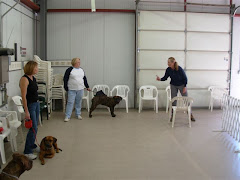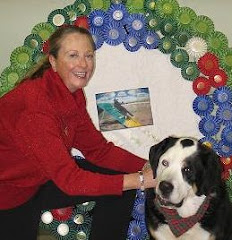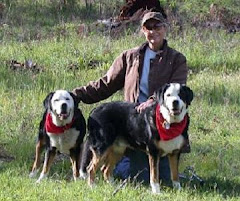 I so sympathize with dog rescue groups and foster families. They try their darnedest to place dogs in appropriate homes and to be up front with the dogs' histories...and yet, so often, the people who adopt these dogs expect WAY, WAY more, WAY too soon, of these dogs that is realistic.
I so sympathize with dog rescue groups and foster families. They try their darnedest to place dogs in appropriate homes and to be up front with the dogs' histories...and yet, so often, the people who adopt these dogs expect WAY, WAY more, WAY too soon, of these dogs that is realistic.Prospective families often have a real rosy picture in their minds of how it will be with the new dog. Generally the decision to adopt a rescue has come after a lot of responsible deliberation and research, and their intentions are great. But their plans are sometimes fatally flawed. "Rescuing," after all, connotes heroism and nobleness. They plan to shower the poor dog with the love, affection and security it has lacked. They expect it to become the perfect family dog...a hiking companion, a ball fetcher for the kids, a devoted dog to snuggle on the couch or at their feet at night, and a dog who loves all the kids' friends but growls at the "bad guys." This dog will be so loved that the dog will naturally want to be good in exchange.
Even though the rescue group tells the prospective family of the dog's faults, the family overlooks them because the dog is cute, or because they believe they can love the dog's objectionable behaviors away. Or they will dismiss the shortcomings disclosed by the rescue group because they think they can make it work anyway.
The first day in the new home is an eye-opener for everyone, including the dog. He is thrust into a new pack, often without firm leadership, and with much more stimulation than he can comfortably handle. Toys, noises, other pets, new feeding rituals, and turmoil from kids....all these can throw him into a tailspin that results in urinating in the house ("But you said he was housebroken!!") to jumping up on the table to steal food ("His manners are awful!") to growling at the children's friends ("You said he was good with kids!") After a few days in the new home, the new family either wants to return the dog to the rescue group, or has consulted a "trainer" who suggests Prozac for the dog!
The Yakima area rescue groups frequently place dogs on Washington's west side, where there are lots of "trainers" in the Yellow Pages, but not many who truly understand dog behavior from the dog's point of view. Using human psychology to fix dog problems DOES NOT WORK. Yes, there are many famous "dog trainers" and "behaviorists" out there who sell many books and DVDs, but I promise you not one of them cares as much for the poor dog as Cesar Millan, "The Dog Whisperer." I'm so very grateful to have been introduced to Cesar a few years ago in my career, as he VALIDATED what we have been practicing for all those years at Manning Dog Training. So let's do a quick review of what Cesar would say about the proper way to integrate a new dog into a new pack....
He'd remind you of the three things every dog needs, in this order:
1. EXERCISE
2. DISCIPLINE
3. AFFECTION
EXERCISE. We, as humans, make the mistake of giving affection first, which is UNNATURAL to a dog, especially a dog in a new pack. The best thing you can do with your new rescue is to immediately take him for a long, purposeful walk TO YOUR HOME. If you have another dog, walk them together...you in the middle, and each dog on a short leash at your side. This is a natural bonding experience; as a pack, you are migrating to a destination, and you are the leader.
DISCIPLINE. The dog IMMEDIATELY needs boundaries, from the first time he steps foot across your threshold. YOU control (with your body and voice) when he can enter, and where he goes. You need not be cross, just firm and friendly (leaders show strong assertive energy.) Avoid talking so much you overwhelm the dog. Let him relax gradually. Keep him on a drag leash for at least several weeks around the house. On his first day, restrict his free access to the house; do not let him explore on his own. He may only wander through the house if you are guiding him on the leash. Make him wait, or "curb," at every doorway through which you pass. If he jumps on furniture, tug him off (yes, even if you intend to allow him up there later. Such privileges must be EARNED with time and good behavior/attitude).
Rather than smothering him with attention, fairly ignore him. Act as if his presence there in your household is nothing new and out of the ordinary. Let him observe and absorb the surroundings at his own rate. Don't try to teach him to shake hands the first day. Simply show him what his boundaries (behaviorwise and otherwise) are.
Put up with absolutely no backtalk or brattiness from the get-go. Squelch attitudinal talk with a sharp "Aghh!" or something similar. And such corrections must happen AS THE DOG IS DOING THE BAD DEED, not 5 seconds later. In 5 seconds, his behavior is ancient history to him, and he will not get the connection between his behavior and your correction.
If you want to move from kitchen to family room, and the dog is reluctant to go with you, take him by the leash and simply move him with you. Don't beg. Don't coax. Don't bribe with treats. Simply be a leader, take this child by the hand (leash) and LEAD. The dog will QUICKLY learn to trust you and your judgment, and to know that you are a person of confidence and conviction.
AFFECTION. At the end of a training session, a walk, or a day, communicate to him with hands and voice how much he means to you, and how much you appreciate him. Dogs, like humans, are accustomed in a natural state to "working" all day and relaxing at night. None of us is accustomed to being smothered with affection all day long...and, in fact, if we were, the affection would lose much of its meaning! We might even come to resent it! Our dogs are exactly the same.
Use a crate. Use it as a safe haven for your dog. Use it arbitrarily, like you'd use a playpen or a crib for a baby. You don't ask the baby whether or not she wants to be in the crib. You place her there for her own good. It is not negotiable, nor is it awful! Crates will save your sanity and allow your dog a quiet place to escape the new turmoil. Without guilt, confine your dog in the crate from the first night (in your bedroom, please, NOT in isolation!!!) and it will become his routine. Whether or not you continue to use it after a month or so, at least start out using it for that long.
Give the new dog time to rest. Make naps part of the daily routine. A new dog will thrive on routine. Once the routines are established and the dog becomes more settled in, then you can start adding variety to his life, to make him a more well rounded being and a better member of society.
If you have problems with your rescue, LOOK TO YOURSELF FIRST. TRAIN YOURSELF TO THINK AND COMMUNICATE like a dog... and the dog will be just fine. If YOU are not trainable, then and only then is it time to consider giving up and allowing the dog to go to a home where the humans can be the leaders the dog needs.


















No comments:
Post a Comment